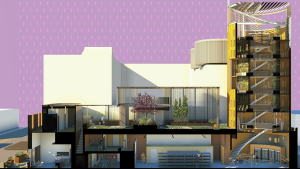As the new president of the Ontario Association of Architects, Settimo Vilardi plans to be the public voice of the OAA and to ensure the organization sees through its strategic plan.
“My platform that I ran on was just to continue to roll out the strategic plan that we had developed over the last two to three years because I was directly part of the planning process,” said Vilardi, who was previously the chair of the Windsor Region Society of Architects.
In addition to reconfirming the association’s commitment to its primary objective as the regulating body for the province’s architecture profession, the five-year strategic plan includes four primary pillars: regulatory leadership, governance and operations, member competency and public education.
These are looked at through the lens of climate action, climate stability, climate emergency, equality, diversity and inclusion (EDI).

Ontario Association of Architects
“Both climate and EDI should be informing any kinds of decisions we’re making,” he noted. “Within each of these foundational goals we have action items that we want to undertake and key progress indicators to know if we’re being successful in each of those goal areas.”
In his new role, he will be the public voice of the OAA, and while advocacy is not the primary objective, it is important, Vilardi said.
“It’s a secondary objective of the organization, to advocate for architecture not necessarily for the architecture profession or for architects specifically,” he noted.
Over the last few years, the organization has spent a lot of time looking internally to ensure it is on track from a governance standpoint and operating as effectively and efficiently as possible.
“The biggest change is that we’ve refocused both the way our operations are organized and the way our regulatory governance is organized to make sure that we’re being as professional, transparent, effective as we can because we have a big responsibility,” he said.
The organization recognizes there are challenges with housing affordability and long-term care in the province and they are looking for ways architects and the profession can support that.
“How as a regulator we can support that initiative,” Vilardi said. “We’ve been looking internally at resources we have as architects and people in the field that are doing multi-unit residential construction or doing housing and trying to understand the efficiency that it would take to increase housing stock across the country.”
There is a lot of discussion about modular construction which would allow things to be built and installed quicker, he added.
“How does that affect the profession and how does it affect public safety?” he said.
Long-term care homes, which were hit hard during the COVID-19 pandemic, are also an area of focus.
“Everybody has a role to play in that,” he said. “Government has a role to play in how they regulate these areas, construction has a role to play and obviously design has a huge role to play in how these spaces are laid out to limit the ability for people to contract various illnesses.
“That’s been another initiative that our profession has been looking very closely at. We’ve been holding internal roundtables and big-think sessions about how we can support what’s going on in the government and initiatives taking place and within the industry and then also looking at partnering with organizations that are undertaking research on long-term care and how it’s being designed and implemented in other parts of the world.”
Follow the author on Twitter @DCN_Angela





Recent Comments
comments for this post are closed